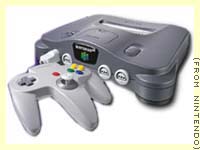
Sega Saturn
1995
Introduced in the spring of 1995, Sega's Saturn, a 32-bit system with more RAM and a CD drive, wooed many gamers from 16-bit rivals. With 3D graphics and digital sound, the Saturn initially did well, selling 100,000 units in the first three days, according to Sega. Over time the system did not do as well as expected and was overshadowed by Sony's PlayStation, released in the U.S. later in the year.
 Sony PlayStation
Sony PlayStation1995
Sony's PlayStation began its life as a CD attachment for the Super NES. When Sony and Nintendo disagreed on how the new device would be marketed, Sony decided to further develop the PlayStation into a game machine of its own. The PlayStation was released in the United States in September 1995, starting the era of 32-bit video games and taking off in popularity. As of May, 2000, one out of every four households in the United States owned a PlayStation.
 Nintendo N64
Nintendo N641996
Nintendo skipped the 32-bit era, dismissing the Sega and Sony console threats while working on its own next-generation machine. The N64, released in the U.S. in 1996, gave a 64-bit boost to the company's classic hits, and featured the more 3-dimensional feel that gamers had come to crave. The N64's imagery was produced by Silicon Graphics, the computer company that brought tornadoes and dinosaurs to life on the big screen. While still a viable force in the gaming world, the N64 is beginning to show its age and gamers are anticipating the release of Nintendo's next console, the GameCube, in 2001.
 Sega Dreamcast
Sega Dreamcast1999
The first console game machine to sport 128-bit architecture, Sega's Dreamcast packed hardware normally found only in a powerful PC. It boasted a 200 MHz processor, a 64 channel audio chip and 26 megabytes of RAM, all dedicated to playing games. This computing power translated into faster, smoother and more detailed action on the screen. The Dreamcast also had a built-in 56K modem to capitalize on the surging popularity of online games.
 Sony PlayStation 2
Sony PlayStation 22000
One of the most widely anticipated game console products, the U.S. version of PlayStation 2 will offer faster game playing speeds, better picture quality and added features DVD movie playback. PS2 contains an expansion bay roomy enough to house a 3.5-inch hard drive as well as a network adapter for Internet access. Despite critical shortages in manufacturing parts, Sony said it still expects to ship 3 million units in North America before March 2001.
 Microsoft Xbox
Microsoft Xbox2001
The Xbox is expected to sport many off-the-shelf PC components when it arrives in stores in late 2001. It will have a stripped down Windows operating system, a 700 MHz processor, 8-gig hard drive, 64 MB of memory, an Ethernet port and a DVD drive. Microsoft is banking on developers accustomed to working with personal computers to produce new games. But some are wondering if the Xbox will suffer for its PC pedigree, since many PC games are optimized for keyboard use and single players.
 Nintendo GameCube
Nintendo GameCube2001
Expected to launch sometime in the Fall of 2001, the GameCube is Nintendo's foray into the 128-bit generation. With a 405 MHz processor and strong lineup of games, GameCube will likely include popular Nintendo titles like Pokemon, Mario and Zelda. Games will come on 3-inch disks on a format incompatible with standard CD and DVD drives, partly to reduce piracy. For that reason, it's not expected to include DVD playback as an option. Other features include wireless game pads and a modem for Internet play.

0 Comments:
Post a Comment
<< Home